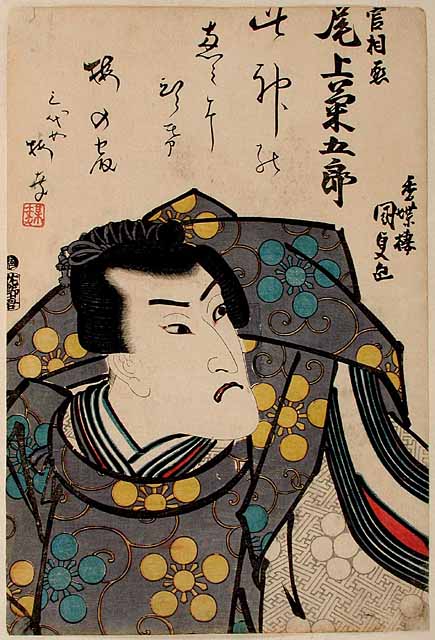
Onoe Kikugoro III as Kan Shojo in Sugawara denju tenarai kagami (Sugawara and the secrets of calligraphy) performed at the Nakamura Theatre in 11/1835
Private collection

Sawamura Gennosuke II as Kan Shojo in Sugawara denju tenarai kagami (Sugawara and the secrets of calligraphy) performed at the Kawarazaki Theatre in 09/1831
Private collection
The blocks cut for actor prints were rarely re-used in the nineteenth century. This comparison of the exceptional re-use of blocks by the Edo publisher Sanoya Kihei shows unhappy but very instructive results.
In 1835 ‘Sugawara and the Secrets of Calligraphy’ was performed at the Nakamura Theatre to great acclaim. Sanoya still had in his possession the blocks for a set of half-length portraits of the leading characters in this play that Kunisada had designed in 1831 when the play was performed at the Kawarazaki Theatre. Unfortunately for Sanoya, the roles were cast differently in 1835. Undeterred, he had the names and faces of the original actors cut from at least two of the old sets of blocks and replaced them with the names, poems and faces of the new performers. The name and poem were changed easily, though without much care for the overall balance. The insertion of the new face was more complex, and the plugging of the blocks all too obvious.
Fewer blocks were used to print the re-issue, thus omitting inner patterns on the kimono. The blocks had not been well cared for, and a break is evident, at the top right point formed by the sleeve tossed behind the actor’s head. The printing and colouring of the re-issue is insensitive. The subtle tones of the original have been replaced by flat colours, while the carefully-judged grey used for the keyblock and texts of the original has been replaced by a thick, uniform black which hardens and clutters the design. In the original such a black was confined to the actor’s hair, pupils and blackened teeth (fashionable during the period of the 10th century in which the play was set).
The re-issue hardly represents Kunisada’s original intention, nor does it meet the standards consumers had come to expect from Sanoya Kihei, who published many of Kunisada’s finest designs from the late 1820s to 1850s. Perhaps pressure to publish quickly in order to cash in on a current hit drove him to allow such an inept re-issue.



